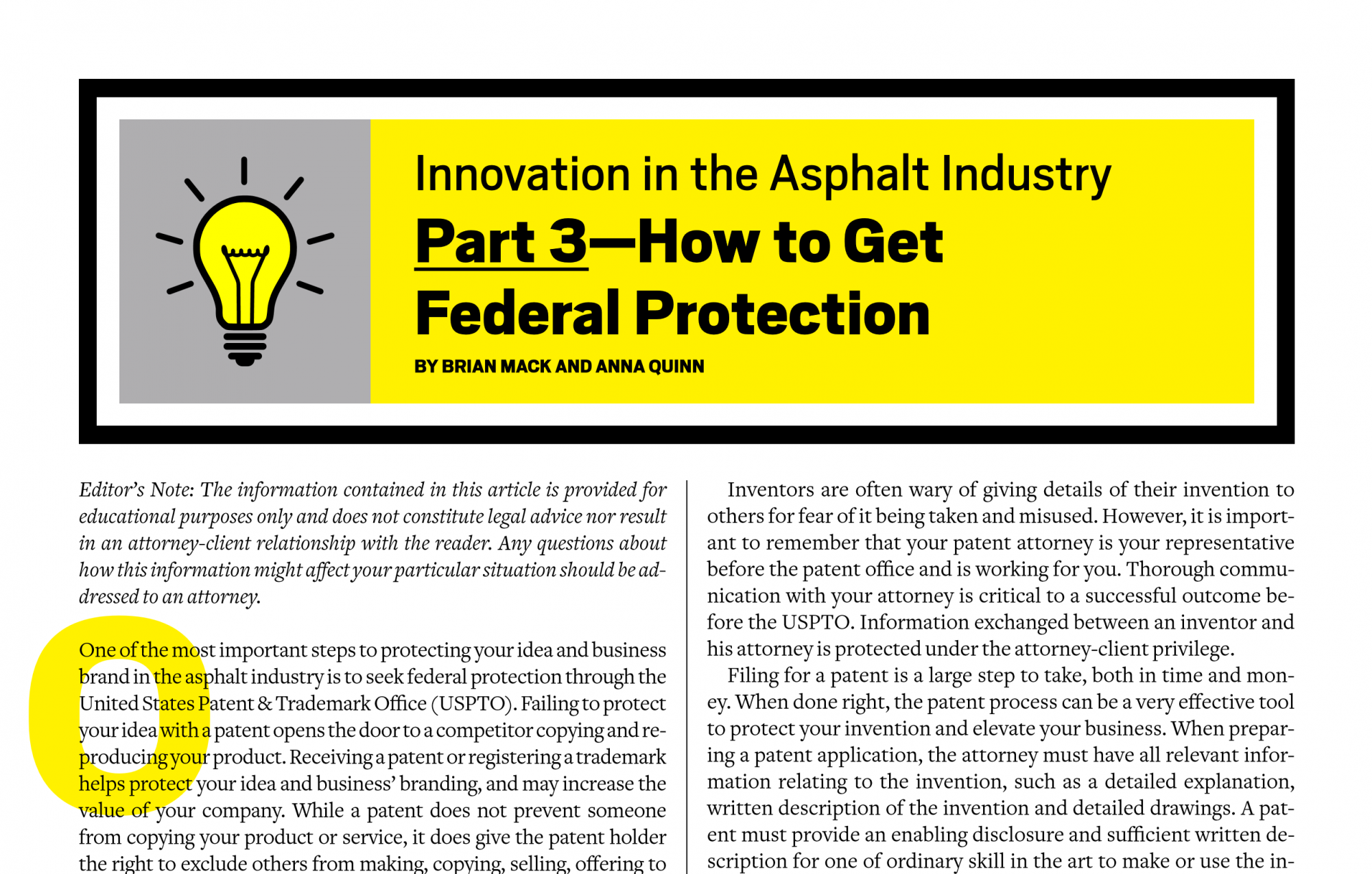Innovation in the Asphalt Industry, Part 3—How to Get Federal Protection
BY Brian Mack and Anna Quinn

Editor’s Note: The information contained in this article is provided for educational purposes only and does not constitute legal advice nor result in an attorney-client relationship with the reader. Any questions about how this information might affect your particular situation should be addressed to an attorney.
One of the most important steps to protecting your idea and business brand in the asphalt industry is to seek federal protection through the United States Patent & Trademark Office (USPTO). Failing to protect your idea with a patent opens the door to a competitor copying and reproducing your product. Receiving a patent or registering a trademark helps protect your idea and business’ branding, and may increase the value of your company. While a patent does not prevent someone from copying your product or service, it does give the patent holder the right to exclude others from making, copying, selling, offering to sell or importing the invention in the United States. Likewise, a federal trademark registration grants the registrant the right to prevent others from using the brand with the same or highly similar goods and services across the United States. It is important to note that the patent or trademark owner must choose to enforce the rights given to him by the USPTO. Below are some important steps to consider taking when trying to protect your intellectual property.
While it is possible for an inventor to try to protect his intellectual property on his own, due to the complexities of the U.S. patent and trademark systems, most inventors use the services of a licensed attorney. For obtaining patent rights, the inventor will seek out a registered patent attorney. A roster of registered patent attorneys can be found on the patent office website (www.uspto.gov). Just as a doctor has a specialty, typically patent attorneys do as well. Patent attorneys have a technical background, often in a specific area of science or engineering. When retaining a patent attorney, it is advisable to inquire about his or her technical areas of expertise. Similarly, attorneys that specialize in trademark matters have expertise in the area of securing trademark rights. Typically, a patent attorney will also be knowledgeable in the area of trademarks, or will work closely with others that are.

Once you’ve decided on representation before the USPTO, your attorney should have you sign an engagement letter outlining the scope and details of their representation. This may or may not include the costs for filing and prosecuting (or pursuing) the patent and/or trademark application. The costs to obtain a patent or trademark will include governmental filing fees as well as the costs that are incurred in the preparation and prosecution of the patent or trademark application.
Inventors are often wary of giving details of their invention to others for fear of it being taken and misused. However, it is important to remember that your patent attorney is your representative before the patent office and is working for you. Thorough communication with your attorney is critical to a successful outcome before the USPTO. Information exchanged between an inventor and his attorney is protected under the attorney-client privilege.
Filing for a patent is a large step to take, both in time and money. When done right, the patent process can be a very effective tool to protect your invention and elevate your business. When preparing a patent application, the attorney must have all relevant information relating to the invention, such as a detailed explanation, written description of the invention and detailed drawings. A patent must provide an enabling disclosure and sufficient written description for one of ordinary skill in the art to make or use the invention. Failing to provide the attorney with sufficient information will result in an application with fewer details and could result in an application that fails to meet the required level of detail under the patent laws.
One optional task to consider prior to applying for a patent is to perform a patent search to try to identify whether there are any other patents or patent applications relating to your product or service. This is a step an inventor can perform through his patent attorney or on his own through a number of free patent search engines (e.g., Google Patent). The information received from the search may be used by the patent attorney to draft an application that has the highest likelihood of success, based on all of the information available to the attorney at the time the application was filed.
Depending on your timing and business situation, there are a couple of different ways to file a patent application. Often a quick and cost-effective approach is to file a provisional patent application. A provisional application is not examined by the USPTO, is not published, has fewer required sections and expires after one year. The provisional application is effectively a place holder for your invention while things such as likelihood of commercial success, developing a business plan, securing investors and testing the invention are evaluated by the inventor or others involved with the business. If a provisional application is filed, the inventor must file a non-provisional patent application prior to the end of one year from the date the provisional application was filed to prevent a loss of patent rights.
The patent application must include a written description of the invention, at least one claim outlining what the inventor believes is the bounds of the invention, and any drawings required to understand the invention. Additional sections may be added, including a background of the invention and a brief summary of the invention. If you file an application for a patent, you should discuss what each section of the patent application means with your attorney and be comfortable with the information provided therein.
Once the application is filed, it will be assigned to an examiner at the USPTO. The examiner will search the invention claimed against prior issued patents, published patent applications and other public documents (collectively called the “prior art”). If the examiner finds that the invention fails to meet the requirements for patentability, the examiner will issue an Office Action. The applicant may respond to the Office Action, and this process can continue back and forth with the patent office until either a patent is granted or the application is abandoned.
The process for securing federal trademark registration is similar to the process for applying for a patent. A trademark functions as a source identifier to help consumers distinguish between products. A trademark registration is not required to use a mark, and common law trademark rights begin accruing the moment use of the mark begins. Common law rights are geographically narrow in scope, however. Therefore, depending on your business, federal trademark registration may be something to consider.
When applying to register a mark, your attorney will prepare the application, which sets forth the mark (which may or may not include a design), what goods or services the mark will be used with, and whether or not the mark is already in use in interstate commerce. A trademark examiner reviews the application to ensure that the mark is not confusingly similar to any other federally registered marks. If the application passes review, the mark is published for 30 days, giving third parties a chance to challenge registration if the third party feels that the mark is too similar to its own brand. Because trademark registration is based on the applicant’s use of the mark in interstate commerce, registration will occur once the applicant successfully shows evidence that the mark is being so used. Trademark registrations may be maintained indefinitely so long as the mark is used and the proper renewal documents are filed.
There have been many great improvements made in the asphalt industry and many more to come. Protecting your intellectual property is a powerful tool that can provide much needed protection to your ideas and innovations.

Brian Mack

Anna Quinn
Brian Mack and Anna Quinn are registered patent attorneys with Lathrop & Gage LLP in Overland Park, Kansas. Their work includes counseling clients on various intellectual property issues including drafting and prosecuting patent applications, trademark applications, licensing patents, enforcing patents, and avoiding patent infringement. Their client base spans different technologies and industries including general mechanical, construction equipment, power generation, aerospace, energy, biological, and chemical industries. For further information, contact Mack at bmack@lathropgage.com or Quinn at aquinn@lathropgage.com, or visit www.lathropgage.com.
